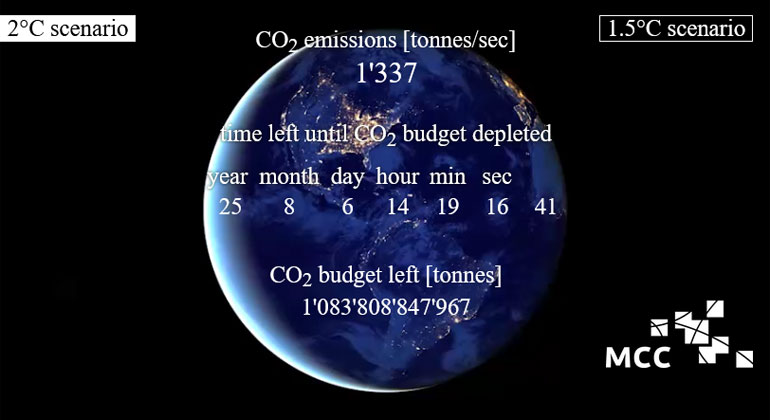That’s how fast the carbon clock is ticking
The MCC Carbon Clock shows how much CO2 can be released into the atmosphere to limit global warming to a maximum of 1.5°C and 2°C, respectively. With just a few clicks, you can compare the estimates for both temperature targets and see how much time is left in each scenario.
As to the scientific basis of the carbon clock, we exclusively draw on data from the Intergovernmental Panel on Climate Change (IPCC), which represents the verified state of research. The IPCC last updated its estimate of the remaining carbon budget in summer 2021, with the presentation of the first part of its Sixth Assessment Report.
According to report (see here, table SMP.2),on the 1.5 degree target, the atmosphere can absorb, calculated from the beginning of 2020, no more than 400 gigatonnes (Gt) of CO2 if we are to stay below the 1.5°C threshold. Annual emissions of CO2 – from burning fossil fuels, industrial processes and land-use change – are estimated to be 42.2 Gt per year, the equivalent of 1,337 tonnes per second. With emissions at a constant level, the budget would be expected to be used up in less than eight years from now. The budget for staying below the 2°C threshold, for its part, of approximately 1,170 Gt, would be exhausted in about 25 years. The budgets are calculated in such a way that it is highly likely that the respective temperature target will be met, that is in two thirds of the climate scenarios examined.
Thus, the clock is ticking, showing how little time is left for political decision-makers to take action. Navigating the MCC website allows for an interactive understanding of the time frame of action required for a given political goal.
With just one click, the upper left-hand corner leads you to the scenario for the 2°C target, and the upper right-hand corner to the 1.5°C target. In both cases, the clock shows the remaining carbon budget—and the remaining time. The MCC’s carbon clock only reflects the remaining budget for CO2; the contribution of other greenhouse gases to global heating is subtracted before calculating this remaining carbon budget.
The concept of the carbon budget is based on a nearly linear relationship between the cumulative emissions and the temperature rise. Nevertheless, this does not mean that the earth would necessarily be 1.5⁰C warmer at the very point in time when the remaining carbon budget for staying below the 1.5⁰C threshold was used up. This is due to, among others, the fact that there is a time lag between the concentration of emissions in the atmosphere and the impact thereof on the temperature.
While the Carbon Clock appears to be a precise measurement of the time left to ensure climate protection, many uncertainty factors remain, such as different definitions of the 1.5°C target as well as different assumptions about the climate sensitivity, the actually attained degree of global warming, and the future development of other greenhouse gases. Furthermore,for the time being, the calculation is based on the assumption that annual emissions, after a dip in the pandemic year of 2020, will remain at the 2019 level from 2021 onwards.
In an interview with the Zurich weekly WOZ (in German), whch was published in 2018, MCC Secretary General Brigitte Knopf has explained in detail how the carbon clock illustrates climate change and indicates the urgency of political action.
Source
Mercator Research Institute on Global Commons and Climate Change (MCC) 2021








